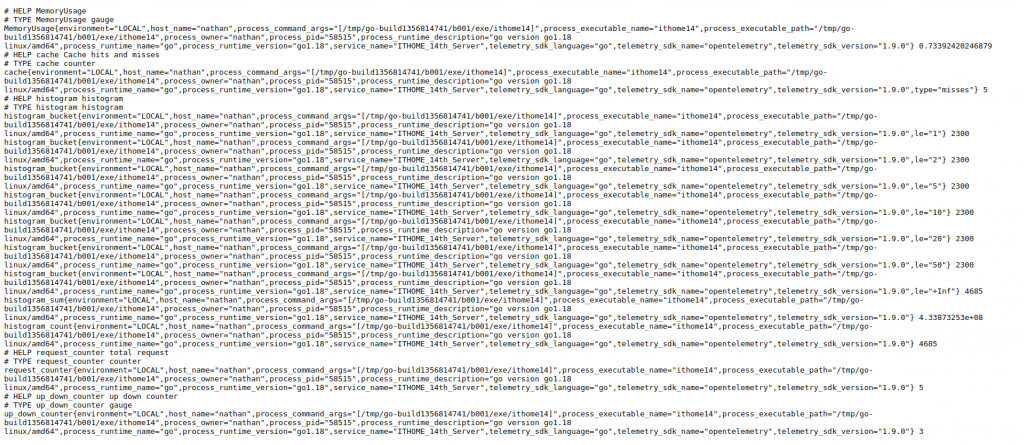今天繼續了解三本柱中的Metrics在OTel中的規範
如同Day6提到的client架構, Otel Metrics也是分成API與SDK兩大部份.

OTel metrics, 需要透過全局的MeterProvider來建立數個Meter並且指定數個Instruments相關連來獲取metrics, 每個INstruments用來建立一系列的Measurements.
這些measurements會在in-memory state(或者稱View)中聚合成一個metric.
Metric reader在讀取出來後, 給Metric Exporter匯出(可以提供Pull/Push).
其中的MeterProvider、Meter與Instruements都是屬於API的範疇.
Async的instrument type, 需要使用Observe去觀察對象的值, 通常用在像是我們去看資源的使用率.
來個很粗淺的範例, 透過Prometheus exporter以及OTel metric
簡單的展示怎麼呈現自定義的metric
package main
import (
"context"
"fmt"
"log"
"math/rand"
"net/http"
"os"
"os/signal"
"time"
"go.opentelemetry.io/otel/attribute"
"go.opentelemetry.io/otel/exporters/prometheus"
"go.opentelemetry.io/otel/metric"
"go.opentelemetry.io/otel/metric/global"
"go.opentelemetry.io/otel/metric/instrument"
"go.opentelemetry.io/otel/metric/unit"
"go.opentelemetry.io/otel/sdk/metric/aggregator/histogram"
controller "go.opentelemetry.io/otel/sdk/metric/controller/basic"
"go.opentelemetry.io/otel/sdk/metric/export/aggregation"
processor "go.opentelemetry.io/otel/sdk/metric/processor/basic"
selector "go.opentelemetry.io/otel/sdk/metric/selector/simple"
"go.opentelemetry.io/otel/sdk/resource"
semconv "go.opentelemetry.io/otel/semconv/v1.10.0"
)
func initMeter() error {
res, err := resource.New(context.Background(),
resource.WithFromEnv(),
resource.WithProcess(),
resource.WithTelemetrySDK(),
resource.WithHost(),
resource.WithAttributes(
// the service name used to display traces in backends
semconv.ServiceNameKey.String("ITHOME_14th_Server"),
attribute.String("environment", "LOCAL"),
),
)
config := prometheus.Config{
DefaultHistogramBoundaries: []float64{1, 2, 5, 10, 20, 50},
}
c := controller.New(
processor.NewFactory(
selector.NewWithHistogramDistribution(
histogram.WithExplicitBoundaries(config.DefaultHistogramBoundaries),
),
aggregation.CumulativeTemporalitySelector(),
processor.WithMemory(true),
),
controller.WithResource(res),
)
exporter, err := prometheus.New(config, c)
if err != nil {
return fmt.Errorf("failed to initialize prometheus exporter: %w", err)
}
global.SetMeterProvider(exporter.MeterProvider())
http.HandleFunc("/", exporter.ServeHTTP)
go func() {
_ = http.ListenAndServe(":2222", nil)
}()
fmt.Println("Prometheus server running on :2222")
return nil
}
func main() {
if err := initMeter(); err != nil {
log.Fatal(err)
}
meter := global.Meter("ithome.com/14th")
go counter(context.Background(), meter)
go counterWithLabels(context.Background(), meter)
go upDownCounter(context.Background(), meter)
go histogramCase(context.Background(), meter)
go gaugeCase(context.Background(), meter)
ctx, stop := signal.NotifyContext(context.Background(), os.Interrupt)
defer stop()
fmt.Println("Example finished updating, please visit :2222")
<-ctx.Done()
}
func gaugeCase(ctx context.Context, meter metric.Meter) {
memoryUsage, _ := meter.AsyncFloat64().Gauge(
"MemoryUsage",
instrument.WithUnit(unit.Bytes),
)
for {
memoryUsage.Observe(ctx, rand.Float64())
time.Sleep(time.Second)
}
}
func counter(ctx context.Context, meter metric.Meter) {
counter, _ := meter.SyncInt64().Counter(
"request counter",
instrument.WithUnit("1"),
instrument.WithDescription("total request"),
)
for {
counter.Add(ctx, 1)
time.Sleep(time.Second)
}
}
func counterWithLabels(ctx context.Context, meter metric.Meter) {
counter, _ := meter.SyncInt64().Counter(
"cache",
instrument.WithDescription("Cache hits and misses"),
)
for {
if rand.Float64() < 0.3 {
// increment hits
counter.Add(ctx, 1, attribute.String("type", "hits"))
} else {
// increments misses
counter.Add(ctx, 1, attribute.String("type", "misses"))
}
time.Sleep(time.Second)
}
}
func upDownCounter(ctx context.Context, meter metric.Meter) {
counter, _ := meter.SyncInt64().UpDownCounter(
"up_down_counter",
instrument.WithUnit("1"),
instrument.WithDescription("up down counter"),
)
for {
if rand.Float64() >= 0.5 {
counter.Add(ctx, +1)
} else {
counter.Add(ctx, -1)
}
time.Sleep(time.Second)
}
}
func histogramCase(ctx context.Context, meter metric.Meter) {
durRecorder, _ := meter.SyncInt64().Histogram(
"histogram",
instrument.WithUnit("microseconds"),
instrument.WithDescription("histogram"),
)
for {
dur := time.Duration(rand.NormFloat64()*5000000) * time.Microsecond
durRecorder.Record(ctx, dur.Microseconds())
time.Sleep(time.Millisecond)
}
}
瀏覽器輸入localhost:2222
會看到類似的數據畫面
有些resource context,是OTel reousce package自動偵測到的內容.
OTel metrics還是希望對現有的流行標準做擴充, 但必須得使用它提供的語意與規範來走.
學習難度相對Prometheus, StatsD都高不少, 因為變成要知道兩邊怎用.

請問雷N大大,之後會有篇幅介紹與 Prometheus 的差異比較嗎?
有打算耶XD
(讓我周末多爬官網學習吸收一下 )